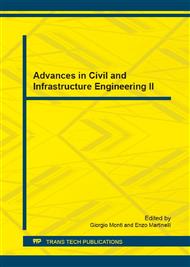p.156
p.166
p.173
p.183
p.191
p.204
p.210
p.222
p.233
Seismic Assessment of Masonry Building Clusters with a Dedicated NLA Software
Abstract:
A building context as complex as that of many historical centers in Europe is the typical scenario where more and more technicians found themselves at work. In addition to the usual difficulty of dealing with the complexity of masonry building clusters, they particularly feel the lack of the essential support of dedicated computational tools. In fact, the calculation codes currently available do not address modeling and analysis of building clusters in a personalized manner. VENUS, Italian acronym for Nonlinear Assessment of Structural Units, is a software developed in C++, which deals with the seismic assessment of building clusters in an integrated manner, accompanying the practitioner from the early stages of defining the level of knowledge, to the management of the design quantities, until the graphic elaboration of the results. Finally, it allows to test the effectiveness of a local intervention with traditional and innovative strengthening techniques and to evaluate its effects on the global response. Finally, a brief description of a stochastic approach foreseen in a future version of the software is discussed.
Info:
Periodical:
Pages:
191-203
Citation:
Online since:
July 2016
Authors:
Price:
Сopyright:
© 2016 Trans Tech Publications Ltd. All Rights Reserved
Share:
Citation:


